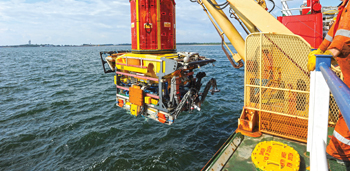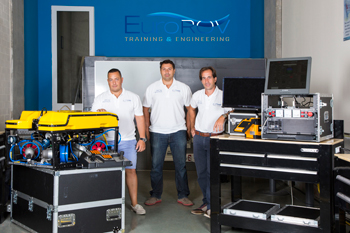
 The global ROV fleet is set to grow 193 units over the period
The global ROV fleet is set to grow 193 units over the period
The Middle East is a bright spot with no downturn in expenditure evident and a CAGR of 6.5 per cent to 2019. It does, however, account for only 10 per cent of overall spend due to the extensive use of divers in the region
The global remotely operated vehicle (ROV) market will significantly contract in value terms in 2016 (-6.3 per cent) and then plateau in 2017, due to the current oil price downturn, anticipates Douglas-Westwood (DW) in its seventh edition of the World ROV Operations Market Forecast 2015-2019.
As per the forecast the market for the operation of work-class ROVs totals $14.2 billion over the period to 2019.
The conclusions of the report highlight the current market challenges with weaker day rates and lower levels of utilisation for the work-class fleet.
Recovery later in the decade results in an overall compound annual growth rate (CAGR) of 4.3 per cent for ROV expenditures over the forecast period. In unit terms, the global fleet is forecast to grow 193 units over the period, from 983 in 2014 to 1,176 in 2019. ROV operational expenditure for the forecast period is expected to total $14.2 billion, an increase of nearly 19 per cent over the previous five-year period.
Drilling support accounts for some 55 per cent of the current market followed by construction support at 29 per cent. The remaining IRM market is the smallest but also the most resilient to downturns in oil price, says the report.
Regionally, the Middle East is a bright spot, with no downturn in expenditure evident and a CAGR of 6.5 per cent to 2019. It does, however, only accounts for 10 per cent of overall spend in 2015 due to the extensive use of divers in the region. Latin America is now the largest market albeit growth levels are somewhat muted at 3.3 per cent CAGR as a result of slowdown in developments in Brazil.
According to the author, Antoine Paillat, comments: 'This represents a 19 per cent increase on the previous five-year period, however, near-term we see some difficult conditions with weaker dayrates and lower levels of utilisation for the work-class fleet. We expect the global ROV market to significantly contract in value terms in 2016 (-6.3 per cent) and then plateau in 2017, due to the current oil price downturn.
'However, we will see recovery later in the decade and this results in an overall compound annual growth rate (CAGR) of 4.3 per cent for ROV expenditure over the forecast period. For the fleet, we expect to see an additional 193 units over the period, increasing from 983 ROVs in 2014 to 1,176 in 2019.'
 |
|
The unmammed underwater vehicle (UUV) market is dominated by North America |
Research team leader and assistant editor, Hannah Lewendon, concludes: 'The team has performed a full refresh of the market model with the latest DW offshore data and revisions to methodology, and sense-checked this through extensive consultation with industry. We found that regionally there were some bright spots, such as the Middle East which sees no downturn in expenditure evident and a CAGR of 6.5 per cent to 2019, although it accounts for only 10 per cent of overall spend in 2015 due to the extensive use of divers in the region. Latin America is now the largest market albeit growth levels are somewhat muted at 3.3 per cent CAGR as a result of slowdown in developments in Brazil.
'We see that drilling support accounts for some 54 per cent of the current market followed by Construction Support at 29 per cent. The remaining IRM market is the smallest but also the most resilient to downturns in oil price. Technology continues to advance, particularly in the Gulf of Mexico market where post-Macondo changes such as API Standard 53 have brought new requirements for ROV blow-out preventer intervention. This has led to a new generation of very large, heavy-duty WROV systems.'
UUV MARKET
Meanwhile, unmanned underwater vehicle (UUV) market is estimated to be worth $4 billion by 2020
According to a new market research report 'Unmanned Underwater Vehicles (UUV) market by type (remotely operated vehicle and autonomous underwater vehicle), ROV and AUV market by Application, by product, by propulsion system, by payload and by geography – global forecasts to 2020,' the global UUV market is estimated at $2.29 billion in 2015 to reach $4.00 billion by 2020, at a projected CAGR of 11.90 per cent from 2015 to 2020.
This growth can be attributed to growing deep-water offshore oil and gas production, rising demand for maritime security and threats and need for ocean data and mapping, globally.
Commercial exploration segment estimated to command new growth in the ROV market, while defense segment will influence Autonomous Underwater Vehicle (AUV) market, among applications.
In the ROV market, commercial segment is growing at a higher CAGR due to huge investment by major players into the commercial usage of ROVs mainly, survey and seabed mapping, offshore drilling and pipeline inspection. In the AUV market, defense segment has highest projected CAGR due to rising demand of anti-submarine warfare, mine countermeasure, and undersea surveillance purposes.
In North America, commercial exploration segment comprises the largest market share of global ROV market and the trend of investment is increasing considering more offshore extraction potentialities. Similarly, due to increasing security concerns, the US and Canada are expected to use AUVs for various defense operations, thus the region is estimated to have the highest market share of global AUV market.
The sensors payload segment of UUV to grow the highest during the forecast period.
The global unmanned underwater vehicle market has been segmented and analysed in terms of payloads, namely, sensors, radars, cameras, lasers, and others.
While the overall market is dominated by the camera segment as the payload is cost-effective and has ample opportunities for more advanced technological developments in near future , the sensors segment is projected to grow at comparatively at the highest CAGR during the forecast period, primarily driven by the increased use of sensors in defense for scanning, detecting, mapping, and remote sensing and to measure the concentration of various elements, compounds, the absorption and the presence of microscopic life.
AFRICA, LATAM TO DRIVE GROWTH
Africa and Latin-America are forecast to be the game changers in the UUV market.
The UUV market is dominated by North America, as of 2015, owing to the technological advancements and the growing incidences of terrorism in the region and more offshore discoveries for deep-water extraction.
However, Africa and Latin-America are expected to drive the growth of the global unmanned underwater vehicle market over the coming years, with the African market projected to grow at comparatively the highest CAGR from 2015 to 2020.
This rapid growth of the African market can be attributed to the oil and gas exploration programmes undertaken by countries such as South Africa and Nigeria and the anti-submarine warfare to support the detection of manned submarine.
Oceaneering International (US): The top player in the UUV market The major players in this market have been identified to be Oceaneering International (US), Kongsberg Maritime (Norway), Teledyne Technologies (US), and Subsea 7 (UK), among others.
Oceaneering International is the major manufacturer and operator of ROVs with a fleet ownership of 332 ROVs to its name. Subsea7 has the second largest ownership of the Remotely Operated Vehicles; it has about 175 ROV in its fleet.











































































hr.jpg)